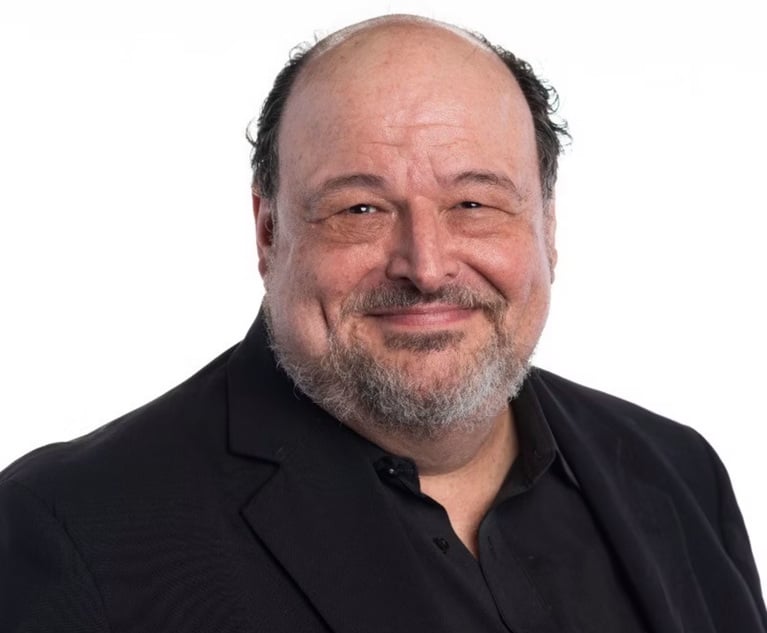Court Erases In-House Lawyer's Billion-Dollar Error
A drafting error in a retirement document altered intended A times B formula to read A times B times B.
October 31, 2010 at 08:00 PM
5 minute read
When Barry Peters was an in-house benefits lawyer for Bell Atlantic Corp.(now Verizon Communications Inc.), he took a legal drafting seminar taught by a professional writer. “There were a number of very helpful suggestions,” he recalls.
Unfortunately, one of the writing tips–avoid placing a phrase at the end of a long, compound sentence that modifies a thought near the beginning of the sentence–contributed to a $1.67-billion error in a retirement plan document Peters drafted for Bell Atlantic.
In an August ruling, the 7th Circuit forgave the error, which would have, for example, awarded former Bell Atlantic employee Cynthia Young, lead plaintiff in the class-action case for 15,000 plan participants, a retirement lump sum of nearly $640,000, compared to the intended sum of $240,000.
The 3-0 decision in Young v. Verizon that Judge John Daniel Tinder of Indianapolis wrote upheld a district court ruling that a federal court could erase Peters' “scrivener's error” under the authority of the Employee Retirement Income Security Act (ERISA).
Honest Mistake
Peters, in an effort to clarify the description of a new retirement plan payout formula, had condensed the text of an A-times-B calculation by shifting the language of B closer to A in a more than 100-word sentence. But he failed to delete the initial B phrase at the end of the sentence. The result was a document that said retirement benefits would be calculated under the formula A times B times B.
“What I failed to do in that fateful moment was take a step back and scan the whole sentence,” Peters says.
The 7th Circuit wasn't kind to Peters or Verizon. The opinion called the mistake “a devastating drafting error in the multi-billion-dollar plan,” which “survived unnoticed in the fifth, sixth, and final drafts of the plan.” The court, noting that only Peters was assigned the in-house drafting work, called the mistake “profound negligence.”
“It is baffling that a major corporation would not invest greater resources to ensure accuracy in drafting such an important document,” Tinder wrote.
In siding with Verizon, the court noted that no plan participant mentioned the A-times-B-times-B formula, adopted in 1996, until Young filed her federal suit in 2005. The court cited ERISA's Section 502(a)(3), which allows plan sponsors and participants “appropriate equity relief” and other appellate decisions that applied such equitable relief under ERISA to a scrivener's error “that the plaintiffs could not have reasonably expected.”
Still, the 7th Circuit decision may not be open-and-shut. In a similar case involving an ERISA plan benefit formula, the 4th Circuit in 2009 ruled against the plan sponsor, Fleet Reserve Association, a not-for-profit advocacy group for current and former enlisted personnel in the U.S. Navy, Marines and Coast Guard. The decision in Cross v. Bragg was broader, in that the Internal Revenue Service had approved plan document alterations by Fleet, but the court nonetheless rejected them.
“When the terms of an ERISA plan are clear and unambiguous, a federal court is obliged to apply it as written,” the court ruled in a unanimous three-judge opinion written by Judge Robert King. But the opinion was delivered as “unpublished,” which could diminish its precedential value.
Matthew Heffner, partner at Susman Heffner & Hurst, who represented Young, says the printed word is especially important under ERISA, which Congress intended to be a largely self-sufficient law. Plan participants are entitled to rely on the plan document language, he says.
“The writing requirements, or the plan documents rule, is as old as ERISA, and it's been used and enforced very harshly against everyone since ERISA has been around,” Heffner says.
Benefits lawyer Edward Veal, senior counsel at Steptoe & Johnson, disagrees. “To say ERISA requires the fiduciaries to follow the plan document and therefore you can't correct a scrivener's error begs the question, because it assumes that scrivener's errors can't be corrected,” he says.
Still, Veal says, “you shouldn't read the 7th Circuit decision as meaning that an employer can retroactively correct its bad judgment about what should have been in the plan. The decision is dealing with real mistakes by the draftsman in implementing what the employer intended.”
Requisite Review
Can mistakes like Peters' be avoided? Peters, now retired, says part of the problem was that Verizon's independent benefits consultant and outside counsel reviewed the documents from their specialized viewpoints, not the viewpoint of a text editor or proofreader.
“There is a certain amount of task sharing,” he says. He dismissed the notion that assigning the in-house drafting work to a single lawyer was wrong. With a document of more than 100 single-spaced pages and at least 1,000 important provisions, the employer needs a single mind to comprehend and express its intent.
“There is a need for consistency,” he says. “It would have been impractical for the corporation to assign two or three people to the drafting. It's far more effective for one person to own the task.”
Veal says it might have been helpful to have the Verizon benefit formula text reviewed by an actuary who had never seen the document but could try to compute a benefit based on the text. “The fresh eye concept could work, but you reach a point where there is just too much labor involved,” he says.
Veal adds that common-sense editing is not encouraged by the verbose boilerplate language used in the IRS model language for retirement plan amendments.
“They are completely unreadable by a layman. In fact, practitioners frequently find them pretty unreadable,” he says. “But nobody really has to read them. The IRS has approved them. As far as retirement plan documents are concerned, the plain language movement has made no inroads at all.”
This content has been archived. It is available through our partners, LexisNexis® and Bloomberg Law.
To view this content, please continue to their sites.
Not a Lexis Subscriber?
Subscribe Now
Not a Bloomberg Law Subscriber?
Subscribe Now
NOT FOR REPRINT
© 2024 ALM Global, LLC, All Rights Reserved. Request academic re-use from www.copyright.com. All other uses, submit a request to [email protected]. For more information visit Asset & Logo Licensing.
You Might Like
View All
'The Show Must Go On': Solo-GC-of-Year Kevin Colby Pulls Off Perpetual Juggling Act

Contract Software Unicorn Ironclad Hires Former Pinterest Lawyer as GC
2 minute read
How Amy Harris Leverages Diversity to Give UMB Financial a Competitive Edge
5 minute read
Auditor Finds 'Significant Deficiency' in FTC Accounting to Tune of $7M
4 minute readTrending Stories
- 1Gibson Dunn Sued By Crypto Client After Lateral Hire Causes Conflict of Interest
- 2Trump's Solicitor General Expected to 'Flip' Prelogar's Positions at Supreme Court
- 3Pharmacy Lawyers See Promise in NY Regulator's Curbs on PBM Industry
- 4Outgoing USPTO Director Kathi Vidal: ‘We All Want the Country to Be in a Better Place’
- 5Supreme Court Will Review Constitutionality Of FCC's Universal Service Fund
Who Got The Work
Michael G. Bongiorno, Andrew Scott Dulberg and Elizabeth E. Driscoll from Wilmer Cutler Pickering Hale and Dorr have stepped in to represent Symbotic Inc., an A.I.-enabled technology platform that focuses on increasing supply chain efficiency, and other defendants in a pending shareholder derivative lawsuit. The case, filed Oct. 2 in Massachusetts District Court by the Brown Law Firm on behalf of Stephen Austen, accuses certain officers and directors of misleading investors in regard to Symbotic's potential for margin growth by failing to disclose that the company was not equipped to timely deploy its systems or manage expenses through project delays. The case, assigned to U.S. District Judge Nathaniel M. Gorton, is 1:24-cv-12522, Austen v. Cohen et al.
Who Got The Work
Edmund Polubinski and Marie Killmond of Davis Polk & Wardwell have entered appearances for data platform software development company MongoDB and other defendants in a pending shareholder derivative lawsuit. The action, filed Oct. 7 in New York Southern District Court by the Brown Law Firm, accuses the company's directors and/or officers of falsely expressing confidence in the company’s restructuring of its sales incentive plan and downplaying the severity of decreases in its upfront commitments. The case is 1:24-cv-07594, Roy v. Ittycheria et al.
Who Got The Work
Amy O. Bruchs and Kurt F. Ellison of Michael Best & Friedrich have entered appearances for Epic Systems Corp. in a pending employment discrimination lawsuit. The suit was filed Sept. 7 in Wisconsin Western District Court by Levine Eisberner LLC and Siri & Glimstad on behalf of a project manager who claims that he was wrongfully terminated after applying for a religious exemption to the defendant's COVID-19 vaccine mandate. The case, assigned to U.S. Magistrate Judge Anita Marie Boor, is 3:24-cv-00630, Secker, Nathan v. Epic Systems Corporation.
Who Got The Work
David X. Sullivan, Thomas J. Finn and Gregory A. Hall from McCarter & English have entered appearances for Sunrun Installation Services in a pending civil rights lawsuit. The complaint was filed Sept. 4 in Connecticut District Court by attorney Robert M. Berke on behalf of former employee George Edward Steins, who was arrested and charged with employing an unregistered home improvement salesperson. The complaint alleges that had Sunrun informed the Connecticut Department of Consumer Protection that the plaintiff's employment had ended in 2017 and that he no longer held Sunrun's home improvement contractor license, he would not have been hit with charges, which were dismissed in May 2024. The case, assigned to U.S. District Judge Jeffrey A. Meyer, is 3:24-cv-01423, Steins v. Sunrun, Inc. et al.
Who Got The Work
Greenberg Traurig shareholder Joshua L. Raskin has entered an appearance for boohoo.com UK Ltd. in a pending patent infringement lawsuit. The suit, filed Sept. 3 in Texas Eastern District Court by Rozier Hardt McDonough on behalf of Alto Dynamics, asserts five patents related to an online shopping platform. The case, assigned to U.S. District Judge Rodney Gilstrap, is 2:24-cv-00719, Alto Dynamics, LLC v. boohoo.com UK Limited.
Featured Firms
Law Offices of Gary Martin Hays & Associates, P.C.
(470) 294-1674
Law Offices of Mark E. Salomone
(857) 444-6468
Smith & Hassler
(713) 739-1250






